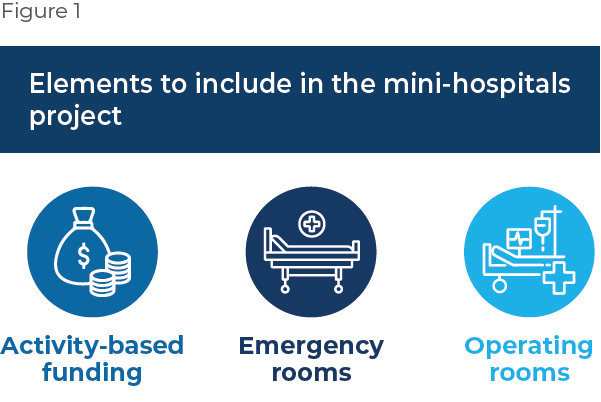The Mini-Hospitals Must Be Built on Solid Foundations

Viewpoint explaining three elements that are essential to the success of the Quebec government’s independent mini-hospitals project
 Related Content
Related Content
 |
 |
 |
| Dubé et Chassin pressés d’introduire des blocs opératoires dans les mini-hôpitaux privés (Le Devoir, February 6, 2024)
L’idée d’avoir des salles d’urgence dans les mini-hôpitaux ne fait pas consensus (La Presse, February 6, 2024) |
Quebec’s plan for ‘mini-hospitals’ has not reached a consensus (City News, February 7, 2024)
Mini-hospitals need ERs and operating rooms to succeed: MEI (The Suburban, February 14, 2024) |
Interview (in French) with Renaud Brossard(Billet de retour, CPAM-AM, February 6, 2024)
Interview (in French) with Emmanuelle B. Faubert (Marceau le midi, BLVD-FM, February 6, 2024) |
This Viewpoint was prepared by Emmanuelle B. Faubert, Economist at the MEI. The MEI’s Health Policy Series aims to examine the extent to which freedom of choice and entrepreneurship lead to improvements in the quality and efficiency of health care services for all patients.
As they do each year, the occupancy rates in Quebec hospitals reached record levels during the holiday season, with a peak of 135% on January 8, 2024.(1) Overworked staff have continued to sound the alarm about the lack of capacity(2) that is leading to considerably longer ER wait times. In certain cases, these waits have even proved fatal.(3)
The mini-hospitals project presented by Premier François Legault and Health and Social Services Minister Christian Dubé during the 2022 election campaign was intended to reduce the growing pressure on hospitals and better meet the needs of the population.(4)
These mini-hospitals were to combine the concepts of a family medicine group (FMG) and a hospital, and to include emergency rooms open 24 hours a day, operating rooms, technical platforms, and various other services that one expects to find in a hospital. During the calls for expressions of interest in the spring of 2023, the purpose of which was to consult potential partners for the project, the government seemed to backpedal on the inclusion of operating rooms, as well as on the possibility of hospitalizing patients for anything more than short periods of observation and treatment.
As the project moves closer to realization, it is important to reiterate the elements that are essential for the success of these mini-hospitals (see Figure 1).

First of all, these mini-hospitals must be funded on an activity basis, if only in part (there must also be sufficient funding to cover capital costs). Moreover, proper emergency rooms and operating rooms are indispensable if they are to really qualify as mini-hospitals, especially since these would help ease overcrowding in the province’s other ERs. These elements, combined with independent administration, would provide the incentives needed to improve the performance of our healthcare system, notably in terms of waiting times.
Without these services that Quebecers are expecting, and an administration model that rewards performance, it is unlikely that the project will succeed in achieving its objectives.(5)
1. Activity-Based Funding
Funding based on fixed budgets, which was historically used in the hospital system, has some significant drawbacks. When a health facility receives a predetermined budgetary envelope, its capacity to respond is limited by the financial resources it has been allocated. Each patient admitted represents additional costs that the facility must cover from a budget that will not increase. As a result, resources are rationed, be they financial, physical, or human. A more efficient hospital that treated more patients than expected would therefore be penalized for its good work.
In contrast, activity-based funding, which assigns values to the different medical acts carried out, rewards those facilities that provide as much care as they can. Indeed, with this mechanism, each additional patient becomes a source of extra revenue for a hospital. The government’s approach of moving gradually from the fixed budget model to activity-based funding will thus be beneficial for the system as a whole.(6) It is absolutely crucial for this mechanism to also be implemented in the mini-hospitals in order to obtain the hoped-for efficiency gains.
2. Emergency Rooms to Ease Hospital Overcrowding
Every day, over 9,000 Quebecers visit one of the province’s emergency rooms.(7) The lack of capacity of these facilities means visitors must suffer patiently. This strong demand, combined with the labour shortage and the poor management of capital, puts a lot of pressure on the system. The inclusion of emergency services in the mini-hospitals will increase supply, which will lighten the load on nearby hospitals by redirecting a portion of the demand.
3. New Operating Rooms
Quebec patients waiting for surgery are faced with another of our system’s significant bottlenecks, especially when it comes to ambulatory surgeries. As of December 30, 2023, 170,829 patients were on a waiting list for surgery.(8) As of December 1st, 48,852 had been waiting for more than six months,(9) including 26,422 waiting for day surgery, which is more than half of them. This wait involves physical suffering as well as financial losses both for the people concerned and for the companies that employ them. The inclusion of operating rooms in the mini-hospitals would increase the capacity of the health care system in terms of surgeries, providing faster relief for patients.
The Positive Effects of Competition
If the foundations upon which the mini-hospitals project rests are not solid enough, this initiative will not bring anything particularly new to Quebec’s healthcare landscape. By combining these three key elements within the independently run mini-hospitals, our healthcare system will be able to benefit from the increased efficiency that competition brings.
Service providers operating in a competitive environment are constantly searching for ways to distinguish themselves and innovate to improve their performance, in an effort to maintain their clientele and capture a bigger share of the market. Healthy competition between hospitals trying to attract new patients would incentivize them to innovate and generate efficiency gains. Once such exemplary practices have been identified, they could then be replicated and adapted elsewhere in the health network, to the benefit of all Quebecers. Indeed, the examples of dental hygienists and of specialized medical centres (SMCs) have demonstrated the benefits of opening health care up to competition.(10)
The time has come to allow increased competition to generate innovative solutions and reduce our interminable waiting lists at long last.
References
- Alice Girard-Bossé, “Un sommet en cinq ans,” La Presse, January 10, 2024.
- Flavie Sauvageau, “Lévis : fatiguées, des infirmières s’absentent et s’inquiètent du recours accru au TSO,” Radio-Canada, January 22, 2024.
- Fanny Lévesque and Ariane Lacoursière, “Des enquêtes à la suite de deux morts à Anna-Laberge,” La Presse, December 5, 2023.
- Coalition Avenir Québec, Nouveaux centres médicaux privés au service des Québécois, consulted January 25, 2024.
- Maria Lily Shaw and Emmanuelle B. Faubert, The Winning Conditions for Quebec’s Mini-Hospitals, Research Paper, MEI, June 2023, p. 13.
- Daniel Boily and Davide Gentile, “Le ministre Dubé veut créer une ‘compétition’ dans le financement des hôpitaux,” Radio-Canada, June 2, 2023.
- Government of Quebec, Tableau de bord – Performance du réseau de la santé et des services sociaux, Urgence, consulted January 25, 2024.
- Government of Quebec, Tableau de bord – Performance du réseau de la santé et des services sociaux, Services médicaux spécialises, consulted January 30, 2024.
- Quebec Department of Health and Social Services, Accès aux services médicaux spécialisés – Volet chirurgie, Sommaire en attente, consulted January 25, 2024.
- Since 2020, dental hygienists can open their own offices without the supervision of dentists. As for SMCs, they provide another point of access for surgical treatments, with the goal of reducing waiting lists. Maria Lily Shaw and Emmanuelle B. Faubert, op. cit., endnote 5, p. 12.

